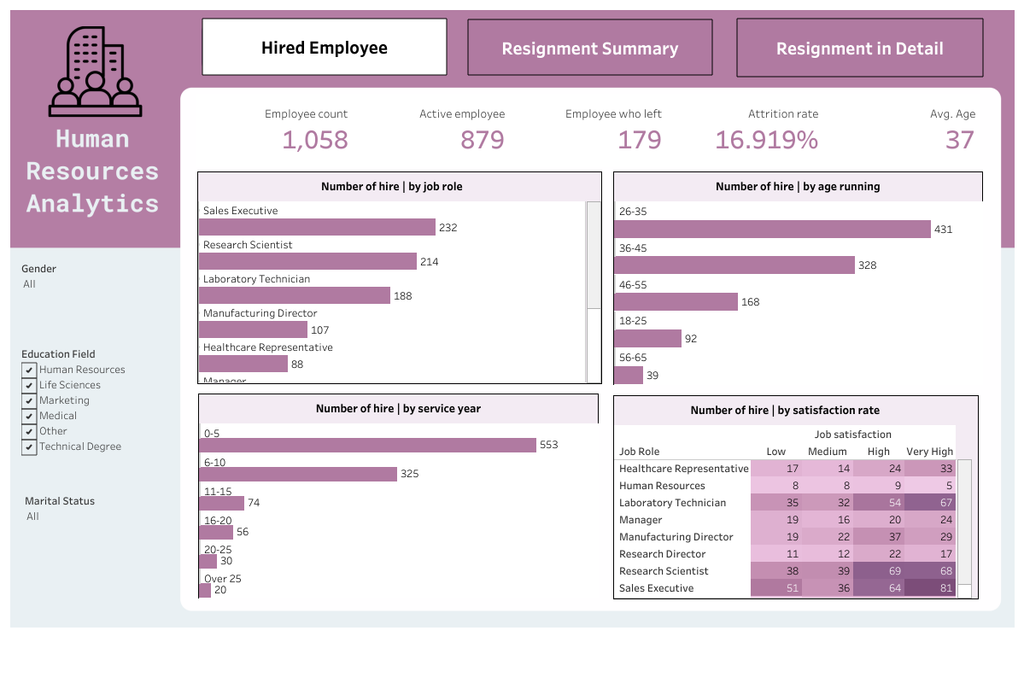Solving High Attrition Rate Problem

Overview
This project aims to find the cause of the high attrition rate in a fictional company called Vidtribe via dashboard building and recommend action items to solve the problem.
Background
Vidtribe has more than 1000 employees, spearheaded across Indonesia. Even though it has become a fairly large company, Vidtribe still has quite a lot of difficulties in managing employees. This has an impact on the high attrition rate (the ratio of the number of employees who leave to the total number of employees) up to more than 10%.
To prevent this from getting worse, HR department managers need help in identifying the various factors that affect the high attrition rate. In addition, it also need to monitor the respective factor by creating a dashboard. After insights found, recommend action item so that the company can lowering the attrition rate by paying attention to the root factor found.
Methodology
- Data Understanding
- Defining Key Business Questions (KBQs)
- Data Preparation
- Data Visualization
- Dashboard Sketching
- Analyzing Trend & Pattern
- Suggest Recommendation
Conclusion
Vidtribe faces a significant challenge in employee retention, particularly within the first five years of service. A consistent trend shows higher attrition rates for employees with less than five years of tenure across all departments, suggesting potential issues with onboarding, training, or initial compensation. This problem is compounded by the fact that the age group with the highest number of hires (26-35 years old) also exhibits the highest resignation rates, especially among men.
Surprisingly, high-performing employees with excellent job satisfaction and work-life balance are also resigning. This challenges conventional wisdom and suggests that factors beyond typical workplace satisfaction, such as compensation, career advancement opportunities, or personal reasons, might be driving these departures. Similarly, the data indicates that neither extensive business travel nor excessive overtime are primary drivers of attrition, as the majority of resigned employees rarely traveled and a higher percentage of those who didn't work overtime resigned.
Recommendation
Based on these insights, Vidtribe should prioritize the following actions to reduce employee turnover:
- Strengthen Early-Career Retention: Focus on improving the experience for new hires, particularly sales representatives and male employees aged 26-35. This involves optimizing the onboarding process, providing robust training, and ensuring competitive compensation and benefits packages during the crucial first five years.
- Understand High-Performer Departures: Implement exit interviews for all resigning employees, especially high-performers and those reporting high job satisfaction and work-life balance. This will uncover specific, underlying reasons for their departures, which may include compensation, limited growth opportunities, or personal factors.
- Implement Stay Interview Programs: Proactively gather feedback from employees who have been with the company for a while. Stay interviews can identify potential issues and areas for improvement before employees decide to leave, helping to retain more tenured staff.
- Investigate Non-Overtime Resignations: Explore why a higher percentage of employees who didn't work overtime are resigning. This could indicate issues like underutilization of skills, boredom, or a lack of engagement, even without excessive hours.
Categories
Objectives
- Extract insights from the given dataset to draw action item so that the company can reduce the high attrition rate
- Build a machine learning model to predict whether the employee will be stayed or resigned
Tools & Technologies
Data Source
HR Analytics dataset